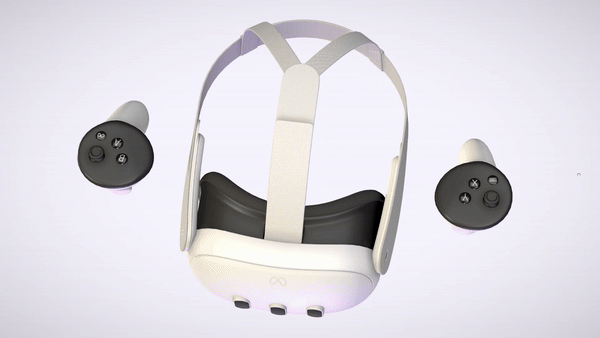Everything you need to know about Apple's Vision Pro Headset
Apple’s Vision Pro Headset is the company’s first foray into the field of mixed reality, which combines elements of virtual reality and augmented reality. The headset was unveiled on June 5, 2023, at Apple’s Worldwide Developers Conference, and is expected to launch on February 2, 2024, in the United States later that year internationally. The headset costs $3,499 (£2,849), which is significantly higher than other VR headsets on the market.
�
The headset features a sleek design that resembles a pair of ski goggles, with a curved glass enclosure and an aluminum alloy frame that wraps around the user’s face. The headset also has a light seal that blocks out stray light and a head band that provides cushioning, breathability, and stretch. It weighs 280 grams and has a two-hour battery life. The battery pack is separate from the headset and can be attached to the user’s belt or pocket with a cable.
�
Also, the display offers more pixels than a 4K TV for each eye, creating a stunning visual experience. There is a built-in camera that captures spatial photos and videos in 3D, which can be viewed on the headset inlcluding audio as well. The headset also supports existing photos and videos from the user’s library, as well as videos taken with iPhone 15 Pro.
�
Unlike most headsets it uses eye tracking, hand tracking, and voice control to navigate the mixed reality environment. The user can access apps, watch movies, write documents, browse the web, and more on an infinite canvas that can be arranged and scaled to the user’s preference. You can also use FaceTime to connect and collaborate with others in a full-size video call that expands in the user’s room. If you want you can use other apps while working on the same document simultaneously with others within FaceTime.
�
The Vision Pro is designed to seamlessly blend digital content with the physical space, allowing the user to do the things they love in ways never before possible. The headset is also intended to be part of a person’s daily life, rather than a device for immersive gaming. However, some critics have questioned whether there is a large market for this kind of wearable technology, and if the high price point and the short battery life will deter potential customers.
�
The decision to create a headset was a bold and ambitious product that marks Apple’s entry into the era of virtual reality. It is expected to be one of the most advanced and innovative mixed reality devices ever created. However, it remains to be seen whether it will live up to its hype and whether it will appeal to mainstream consumers.
The headset has the following technical specifications:
�
– Weight: 280 grams
– Battery life: 2 hours
– Battery pack: Separate, wired
– Display: More pixels than a 4K TV for each eye
– Camera: 3D, spatial photos and videos
– Audio: Spatial audio
– Input: Eye tracking, hand tracking, voice control
�
The headset allows the user to access apps, watch movies, write documents, browse the web, and more on an infinite canvas that can be arranged and scaled to the user’s preference. The user can also use FaceTime to connect and collaborate with others in a life-size video call that expands in the user’s room. The user can also use apps to work on the same documents simultaneously with others within FaceTime.
�
The headset is designed to seamlessly blend digital content with the physical space, allowing the user to do the things they love in ways never before possible. The headset is also intended to be part of the user’s daily life, rather than a device for immersive gaming. However, some critics have questioned whether there is a large market for this kind of wearable tech, and whether the high price point and the short battery life will deter potential customers.
�
Apple’s Vision Pro Headset is a bold and ambitious product that marks Apple’s entry into the era of spatial computing. It is expected to be one of the most advanced and innovative mixed reality devices ever created. However, it remains to be seen whether it will live up to its hype and whether it will appeal to mainstream consumers.
�
How does it compare to the competition?
�
�
Apple’s Vision Pro Headset faces competition from other mixed reality headsets on the market, such as Meta Quest 3, Meta Quest Pro, Pimax Reality 12K QLED, and Xreal Air 2 Pro. Here is a brief comparison of some of their features:
�
| Headset | Price | Weight | Display | Resolution | Refresh Rate | Battery Life | Input |
|———|——-|——–|———|————|————–|————–|——-|
| Apple Vision Pro | $3,499 (£2,849) | 280 g | 2 x Micro-OLED | More pixels than a 4K TV per eye | 90 Hz | 2 hours | Eye tracking, hand tracking, voice control |
| Meta Quest 3 | $499 (£479) | 515 g | 2 x LCD | 2,064 x 2,208 pixels per eye | Up to 120 Hz | 2 hours 12 minutes | Hand tracking, touch controllers |
| Meta Quest Pro | $999 (£999) | 722 g | 2 x LCD quantum dot | 1,832 x 1,920 pixels per eye | Up to 90 Hz | 2 hours | Hand tracking, touch controllers |
| Pimax Reality 12K QLED | $2,399 (£1,799) | N/A | 2 x QLED | N/A | Up to 200 Hz | N/A | Eye tracking |
| Xreal Air 2 Pro | $410 (£299) | N/A | 2 x Micro OLED | 1,920 x 1,080 pixels per eye | Up to 120 Hz | N/A | Hand tracking |
�
As we can see from the table above, Apple’s Vision Pro Headset has some advantages over its competitors in terms of display quality and input methods. However, it also has some disadvantages in terms of price, weight, and battery life. Depending on the user’s preferences and needs, they may find other headsets more suitable or affordable for their mixed reality experience.

The Imersar Engine is our own set of tools that run within the Unity Game Development Engine. The tool set provides a reusable codebase of functionality that covers everything needed to create an immersive experience: Content Management, API integration, usability, navigation and much more. This toolset is continually added to.


Imersar Virtual Reality and Immersive Experiences are available on the following platforms for VR, Desktop and Mobile

Imersar is a B2B software company based in the UK and France. We create bespoke immersive applications for desktop, mobile and Virtual Reality.
The Imersar Virtual Museum of the Grace Dieu is a free to access virtual museum online.
